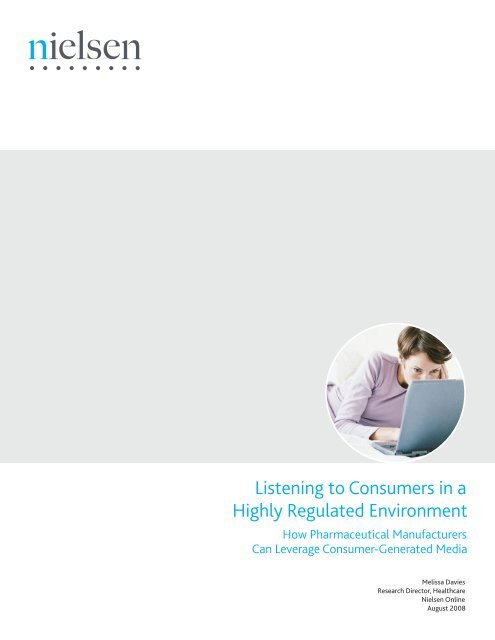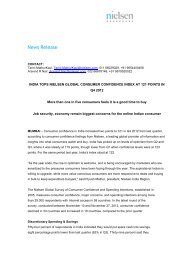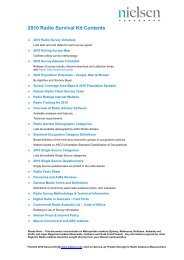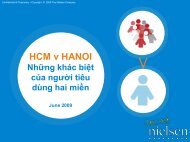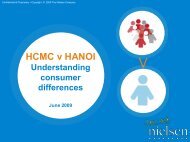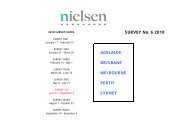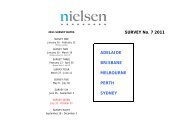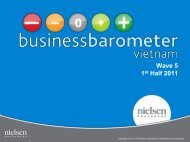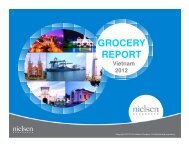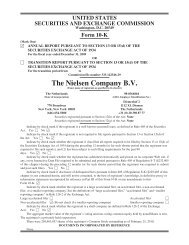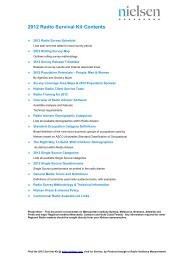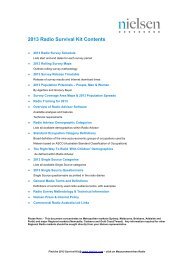Listening to Consumers in a Highly Regulated Environment - Nielsen
Listening to Consumers in a Highly Regulated Environment - Nielsen
Listening to Consumers in a Highly Regulated Environment - Nielsen
You also want an ePaper? Increase the reach of your titles
YUMPU automatically turns print PDFs into web optimized ePapers that Google loves.
<strong>Listen<strong>in</strong>g</strong> <strong>to</strong> <strong>Consumers</strong> <strong>in</strong> a<br />
<strong>Highly</strong> <strong>Regulated</strong> <strong>Environment</strong><br />
How Pharmaceutical Manufacturers<br />
Can Leverage Consumer-Generated Media<br />
Melissa Davies<br />
Research Direc<strong>to</strong>r, Healthcare<br />
<strong>Nielsen</strong> Onl<strong>in</strong>e<br />
August 2008
<strong>Listen<strong>in</strong>g</strong> <strong>to</strong> <strong>Consumers</strong> <strong>in</strong> a<br />
<strong>Highly</strong> <strong>Regulated</strong> <strong>Environment</strong><br />
Table of Contents<br />
Market Context ........................................................ 1<br />
The Challenges of <strong>Listen<strong>in</strong>g</strong> .................................. 2<br />
Sidebar:<br />
Adverse Event Report<strong>in</strong>g .................................. 2<br />
The Benefits of <strong>Listen<strong>in</strong>g</strong> ....................................... 4<br />
Case Study:<br />
CGM Provides an Early Alert ........................... 4<br />
Gett<strong>in</strong>g Started ........................................................ 5<br />
About <strong>Nielsen</strong> Onl<strong>in</strong>e<br />
<strong>Nielsen</strong> Onl<strong>in</strong>e, a service of The <strong>Nielsen</strong> Company, delivers comprehensive, <strong>in</strong>dependent measurement and analysis of onl<strong>in</strong>e<br />
audiences, advertis<strong>in</strong>g, video, consumer-generated media, word of mouth, commerce and consumer behavior, and <strong>in</strong>cludes products<br />
previously marketed under the <strong>Nielsen</strong>//NetRat<strong>in</strong>gs and <strong>Nielsen</strong> BuzzMetrics brands. With high quality, technology-driven products<br />
and services, <strong>Nielsen</strong> Onl<strong>in</strong>e enables clients <strong>to</strong> make <strong>in</strong>formed bus<strong>in</strong>ess decisions regard<strong>in</strong>g their Internet, digital and market<strong>in</strong>g<br />
strategies. For more <strong>in</strong>formation, please visit www.nielsen-onl<strong>in</strong>e.com.<br />
This whitepaper is provided by The <strong>Nielsen</strong> Company for <strong>in</strong>formational purposes only and is not <strong>in</strong>tended and should not be construed<br />
as regula<strong>to</strong>ry or legal advice. Readers should consult with and obta<strong>in</strong> the advice of their company’s market<strong>in</strong>g, regula<strong>to</strong>ry and legal<br />
departments before tak<strong>in</strong>g any actions of significance relat<strong>in</strong>g <strong>to</strong> the subject matter here<strong>in</strong>.
Market Context:<br />
The Empowered Consumer<br />
The roles of consumers and corporations have changed<br />
significantly s<strong>in</strong>ce the rise of the Internet. YouTube is only the<br />
latest manifestation of a broader trend: consumers have the<br />
ability <strong>to</strong> voice op<strong>in</strong>ions about products and brands, and there<br />
is now little stand<strong>in</strong>g <strong>in</strong> their way.<br />
<strong>Consumers</strong> have come <strong>to</strong> expect that<br />
companies can and should listen <strong>to</strong><br />
their ideas, requests and questions,<br />
and that companies will react <strong>to</strong> this<br />
<strong>in</strong>put. A broad range of traditional<br />
companies—<strong>in</strong>clud<strong>in</strong>g Pur<strong>in</strong>a, Mattel,<br />
American Airl<strong>in</strong>es and Comcast, <strong>to</strong> name<br />
just a few—have quickly learned the<br />
importance of listen<strong>in</strong>g and respond<strong>in</strong>g<br />
<strong>to</strong> what their consumers are say<strong>in</strong>g.<br />
Companies are be<strong>in</strong>g held <strong>to</strong> <strong>in</strong>creas<strong>in</strong>gly<br />
high standards set by organizations that<br />
excel at listen<strong>in</strong>g and respond<strong>in</strong>g, such<br />
as Zappos, Geico, Starbucks, Southwest<br />
Airl<strong>in</strong>es and others. These companies are<br />
sett<strong>in</strong>g the bar not just for their direct<br />
competi<strong>to</strong>rs, but for all bus<strong>in</strong>esses that<br />
serve consumers.<br />
<strong>Consumers</strong> who feel they are not be<strong>in</strong>g<br />
heard will turn <strong>to</strong> other channels <strong>to</strong><br />
share their op<strong>in</strong>ions and express their<br />
frustration. Many choose the Internet—<br />
and specifically social media sites<br />
<strong>in</strong>clud<strong>in</strong>g discussion boards, blogs and<br />
onl<strong>in</strong>e groups. Specific <strong>to</strong> healthcare, a<br />
Pew Foundation study f<strong>in</strong>ds that 39%<br />
of patients already use onl<strong>in</strong>e support<br />
groups <strong>to</strong> discuss medications or<br />
1 <strong>Listen<strong>in</strong>g</strong> <strong>to</strong> <strong>Consumers</strong> <strong>in</strong> a <strong>Highly</strong> <strong>Regulated</strong> <strong>Environment</strong><br />
treatments with other patients—and this<br />
is a number that can only grow, given the<br />
size of the onl<strong>in</strong>e population <strong>to</strong>day and<br />
the <strong>in</strong>creas<strong>in</strong>g number of social media<br />
sites just a few clicks away.<br />
Why is social media such a strong<br />
resource for patients and caregivers?<br />
The anonymity of the Internet affords a<br />
comfort level that encourages <strong>in</strong>dividuals<br />
<strong>to</strong> share details about their symp<strong>to</strong>ms,<br />
treatment his<strong>to</strong>ry, experiences with their<br />
doc<strong>to</strong>rs, the efficacy and side effects of<br />
medication, the impact of their condition<br />
on their own lives and more. At the<br />
same time, the ubiquity of the Internet<br />
can provide a connection between<br />
experienced patients and someone newly<br />
diagnosed. That is a powerful draw for<br />
anyone new <strong>to</strong> a particular disease and<br />
unsure about what the future holds.<br />
F<strong>in</strong>d<strong>in</strong>g a community of <strong>in</strong>dividuals<br />
who have a shared experience is equally<br />
powerful for veteran patients, who return<br />
<strong>to</strong> onl<strong>in</strong>e discussion aga<strong>in</strong> and aga<strong>in</strong> <strong>to</strong><br />
seek and share emotional support as they<br />
cont<strong>in</strong>ue on the path of treatment and<br />
liv<strong>in</strong>g with their condition.<br />
Companies <strong>to</strong>day face an <strong>in</strong>creas<strong>in</strong>gly<br />
difficult challenge: how <strong>to</strong> communicate<br />
with consumers <strong>in</strong> a way that encourages<br />
trust and engagement, <strong>in</strong> an environment<br />
where companies’ statements and actions<br />
are rout<strong>in</strong>ely dissected on the Internet for<br />
the entire world <strong>to</strong> see. Pharmaceutical<br />
companies (so far) have escaped the<br />
most public of lash<strong>in</strong>gs; however, patients<br />
are tak<strong>in</strong>g an <strong>in</strong>creas<strong>in</strong>gly proactive role<br />
as healthcare consumers, mean<strong>in</strong>g that<br />
pharmaceutical marketers and brand<br />
managers now must navigate new and<br />
unfamiliar waters. What can pharma<br />
companies do <strong>to</strong> change this dynamic<br />
and open a door of communication with<br />
<strong>to</strong>day’s empowered consumer? The<br />
answer <strong>to</strong> this question is complicated<br />
by the heavy regulation around the<br />
healthcare <strong>in</strong>dustry, but one th<strong>in</strong>g is clear:<br />
pharmaceutical manufacturers have a lot<br />
<strong>to</strong> ga<strong>in</strong> by listen<strong>in</strong>g <strong>to</strong> the conversation<br />
that is already tak<strong>in</strong>g place.
The Challenges of <strong>Listen<strong>in</strong>g</strong><br />
There can be no doubt that<br />
creat<strong>in</strong>g a listen<strong>in</strong>g culture<br />
presents a challenge for many<br />
companies, <strong>in</strong>clud<strong>in</strong>g pharmaceuticals.<br />
In certa<strong>in</strong> corners<br />
of corporate America, a<br />
“listen<strong>in</strong>g as liability” m<strong>in</strong>dset<br />
has prevailed.<br />
Many companies are <strong>in</strong>timidated by the<br />
procedures that must be put <strong>in</strong> place<br />
for logg<strong>in</strong>g consumer feedback, see<strong>in</strong>g<br />
that it gets <strong>to</strong> the right place and, most<br />
importantly, follow<strong>in</strong>g through.<br />
More than possibly any other <strong>in</strong>dustry,<br />
the pharmaceutical <strong>in</strong>dustry is<br />
constra<strong>in</strong>ed <strong>in</strong> how it communicates<br />
with its cus<strong>to</strong>mers—exemplified<br />
by the advertis<strong>in</strong>g real estate that<br />
pharmaceutical companies must<br />
allocate <strong>to</strong> side effects and possible<br />
adverse events (AEs) associated<br />
with their products. It is completely<br />
understandable that the constra<strong>in</strong>ts<br />
around pharmaceutical companies’ ability<br />
<strong>to</strong> speak <strong>to</strong> their cus<strong>to</strong>mers would affect<br />
how they listen <strong>to</strong> their cus<strong>to</strong>mers. We<br />
believe, however, that the two do not<br />
need <strong>to</strong> go hand <strong>in</strong> hand; that there are<br />
ample opportunities for pharmaceutical<br />
manufacturers <strong>to</strong> listen <strong>to</strong> their<br />
cus<strong>to</strong>mers, and <strong>to</strong> better serve the public<br />
and ga<strong>in</strong> competitive advantage by<br />
do<strong>in</strong>g so.<br />
2 <strong>Listen<strong>in</strong>g</strong> <strong>to</strong> <strong>Consumers</strong> <strong>in</strong> a <strong>Highly</strong> <strong>Regulated</strong> <strong>Environment</strong><br />
Social Media and<br />
Adverse Event Report<strong>in</strong>g<br />
Any pharmaceutical company consider<strong>in</strong>g an entry <strong>in</strong><strong>to</strong> the social media space<br />
will naturally wonder about discussion of adverse events. Are consumers shar<strong>in</strong>g<br />
<strong>in</strong>formation onl<strong>in</strong>e that would <strong>in</strong>dicate an adverse experience? Does social media<br />
moni<strong>to</strong>r<strong>in</strong>g trigger the AE report<strong>in</strong>g requirement?<br />
At this writ<strong>in</strong>g, there is no FDA guidel<strong>in</strong>e or regulation that specifically covers<br />
the content of onl<strong>in</strong>e discussion <strong>in</strong> a way that is different from report<strong>in</strong>g<br />
AE <strong>in</strong>formation derived from any other source. Current FDA guidel<strong>in</strong>es give<br />
four parameters for submitt<strong>in</strong>g <strong>in</strong>formation about adverse experiences: the<br />
pharmaceutical company should have knowledge of (i) an identifiable patient;<br />
(ii) an identifiable reporter; (iii) a specific drug or biologic <strong>in</strong>volved <strong>in</strong> the event;<br />
and (iv) an adverse event or fatal outcome. (From FDA’s “Guidance for Industry:<br />
Postmarket<strong>in</strong>g Adverse Experience Report<strong>in</strong>g for Human Drug and Licensed<br />
Biological Products: Clarification of What <strong>to</strong> Report,” issued August 1997;<br />
available onl<strong>in</strong>e at: http://www.fda.gov/cder/guidance/1830fn1.pdf.) Accord<strong>in</strong>g<br />
<strong>to</strong> the guidel<strong>in</strong>e: “If any of these basic elements rema<strong>in</strong> unknown after be<strong>in</strong>g<br />
actively sought by the applicant, manufacturer, or licensed manufacturer, a<br />
report on the <strong>in</strong>cident should not be submitted <strong>to</strong> the FDA because reports<br />
without such <strong>in</strong>formation make <strong>in</strong>terpretation of their significance difficult, at<br />
best, and impossible, <strong>in</strong> most <strong>in</strong>stances” (emphasis added). A draft guidel<strong>in</strong>e for<br />
fil<strong>in</strong>g <strong>in</strong>dividual case safety reports related <strong>to</strong> OTC treatments was posted on the<br />
FDA website <strong>in</strong> Oc<strong>to</strong>ber 2007; it reiterates these same four parameters and aga<strong>in</strong><br />
states that the responsible person should “wait <strong>to</strong> submit a report on the <strong>in</strong>cident<br />
<strong>to</strong> the FDA until the <strong>in</strong>formation is obta<strong>in</strong>ed.”<br />
This raises a key question: When adverse experiences are mentioned with<strong>in</strong><br />
consumer-generated media (CGM), do they meet the FDA’s criteria for report<strong>in</strong>g?<br />
In a recent <strong>Nielsen</strong> analysis of 500 healthcare-related messages posted onl<strong>in</strong>e<br />
across multiple disease categories, <strong>Nielsen</strong>’s BuzzMetrics analysts found only<br />
(cont<strong>in</strong>ued)
one message that <strong>in</strong>corporated the <strong>in</strong>formation needed <strong>to</strong> meet<br />
all four of the FDA’s AE report<strong>in</strong>g requirements (see chart for<br />
details). In this message, a caregiver whose mother was tak<strong>in</strong>g<br />
chemotherapy reported that her mother experienced abdom<strong>in</strong>al<br />
fluid retention, noted that this was not a listed side effect of the<br />
medication, and <strong>in</strong>quired <strong>in</strong> the onl<strong>in</strong>e community whether this<br />
fluid retention might be a sign that the medication was work<strong>in</strong>g.<br />
A note on identifiable reporters: Though the FDA guidel<strong>in</strong>e<br />
does not specify what constitutes an identifiable reporter, the<br />
2007 draft guidel<strong>in</strong>e for OTC report<strong>in</strong>g notes that <strong>in</strong> order for an<br />
AE report <strong>to</strong> be submitted <strong>to</strong> the FDA, there should be “sufficient<br />
<strong>in</strong>formation for the responsible person <strong>to</strong> follow-up, such as a<br />
phone number or e-mail address.”<br />
Most onl<strong>in</strong>e discussion communities discourage the use of<br />
personally identifiable <strong>in</strong>formation. This is especially true with<strong>in</strong><br />
healthcare communities, where personal privacy is even more<br />
carefully guarded. For example, WebMD’s Terms and Conditions<br />
of Use <strong>in</strong>clude the follow<strong>in</strong>g: “To protect your privacy, you agree<br />
that you will not submit any media that conta<strong>in</strong>s Personally<br />
Identifiable Information (like name, phone number, e-mail<br />
address or web site URL) of you or of anyone else.” Other<br />
websites use similar language <strong>to</strong> caution participants aga<strong>in</strong>st<br />
reveal<strong>in</strong>g personal <strong>in</strong>formation.<br />
In the recent analysis of 500 messages, <strong>Nielsen</strong>’s BuzzMetrics<br />
analysts found that 56 messages (11%) conta<strong>in</strong>ed identify<strong>in</strong>g<br />
<strong>in</strong>formation that could be used <strong>to</strong> reach out <strong>to</strong> an <strong>in</strong>dividual <strong>to</strong><br />
follow up on a possible AE report. It is important <strong>to</strong> note that all<br />
of these messages came from Yahoo! or Google groups, rather<br />
than from discussion boards. Groups use their members’ e-mail<br />
addresses as their onl<strong>in</strong>e identification; this is a key difference<br />
from discussion boards, which use less identifiable screen names<br />
for members’ onl<strong>in</strong>e ID. This use of e-mail addresses provides<br />
contact <strong>in</strong>formation that could be used <strong>to</strong> follow up with<br />
a reporter <strong>to</strong> gather the details that would be needed for<br />
an AE report.<br />
3 <strong>Listen<strong>in</strong>g</strong> <strong>to</strong> <strong>Consumers</strong> <strong>in</strong> a <strong>Highly</strong> <strong>Regulated</strong> <strong>Environment</strong><br />
A<br />
B<br />
C<br />
D<br />
E<br />
F<br />
B<br />
494 messages mention an identifiable patient<br />
100 messages mention a specific medication<br />
56 messages mention an identifiable reporter<br />
D<br />
14 messages mention both a specific medication and an<br />
identifiable reporter<br />
4 messages mention an adverse experience and <strong>in</strong>clude an<br />
identifiable patient and a specific medication<br />
1 message also <strong>in</strong>cludes an identifiable reporter<br />
Among 500 messages analyzed, one message<br />
<strong>in</strong>corporated all four AE report<strong>in</strong>g criteria<br />
It is clear that a pharmaceutical company that aggressively<br />
moni<strong>to</strong>rs social media may pick up the occasional AE with<strong>in</strong><br />
patient/caregiver onl<strong>in</strong>e discussion. <strong>Nielsen</strong> Onl<strong>in</strong>e’s experience<br />
is that this happens very rarely, with a volume that is entirely<br />
manageable with<strong>in</strong> companies' broader AE moni<strong>to</strong>r<strong>in</strong>g programs.<br />
E<br />
F<br />
C<br />
A
The Benefits of <strong>Listen<strong>in</strong>g</strong><br />
Follow<strong>in</strong>g are just a few examples of<br />
the learn<strong>in</strong>g opportunities social media<br />
research presents:<br />
Understand patients’ questions<br />
Patients who are new <strong>to</strong> a medication<br />
often have questions about how and<br />
when <strong>to</strong> take it. In many cases, these<br />
questions may not occur <strong>to</strong> the patient<br />
dur<strong>in</strong>g the <strong>in</strong>itial doc<strong>to</strong>r visit. Patients<br />
often turn <strong>to</strong> the experiences of others<br />
with<strong>in</strong> the onl<strong>in</strong>e community for<br />
answers. Understand<strong>in</strong>g the questions<br />
that typically come up can <strong>in</strong>form the<br />
language used <strong>in</strong> brand packag<strong>in</strong>g<br />
<strong>in</strong>serts, patient education materials,<br />
Web site content, DTC market<strong>in</strong>g and<br />
even conversations between sales reps<br />
and doc<strong>to</strong>rs.<br />
Learn about patients’ experiences<br />
us<strong>in</strong>g the product<br />
Is the packag<strong>in</strong>g hard <strong>to</strong> open? Does<br />
the patch fail <strong>to</strong> peel away from the<br />
protective back<strong>in</strong>g—or fall off <strong>to</strong>o easily<br />
after it is applied? Is the eye dropper <strong>to</strong>o<br />
short <strong>to</strong> get the last dose of medication<br />
out of the bottle? This type of feedback<br />
can quickly bubble <strong>to</strong> the surface with<strong>in</strong><br />
onl<strong>in</strong>e discussion.<br />
Avoid response bias<br />
A challenge of market research is<br />
overcom<strong>in</strong>g respondent bias. Follow<strong>in</strong>g<br />
4 <strong>Listen<strong>in</strong>g</strong> <strong>to</strong> <strong>Consumers</strong> <strong>in</strong> a <strong>Highly</strong> <strong>Regulated</strong> <strong>Environment</strong><br />
consumer conversations that are tak<strong>in</strong>g<br />
place naturally <strong>in</strong> the onl<strong>in</strong>e environment<br />
allows researchers <strong>to</strong> avoid respondent<br />
bias by study<strong>in</strong>g the full scope of<br />
consumer feedback—the good, the bad<br />
and the ugly. This can be a humbl<strong>in</strong>g experience<br />
and <strong>in</strong> some cases brand managers<br />
will need <strong>to</strong> brace themselves for what<br />
they will learn. However, many marketers<br />
believe that a proactive approach <strong>to</strong><br />
learn<strong>in</strong>g about issues be<strong>in</strong>g discussed is<br />
preferrable <strong>to</strong> react<strong>in</strong>g <strong>to</strong> an issue already<br />
snowball<strong>in</strong>g with<strong>in</strong> consumer discussion.<br />
Expand the feedback base<br />
The sheer number of patients and<br />
caregivers who are participat<strong>in</strong>g <strong>in</strong> onl<strong>in</strong>e<br />
discussion creates an opportunity <strong>to</strong><br />
collect data from a much larger sample<br />
than is often possible through survey or<br />
focus group research.<br />
Answer questions the brand team<br />
didn’t th<strong>in</strong>k <strong>to</strong> ask<br />
Even the best survey <strong>in</strong>struments cannot<br />
uncover the answers <strong>to</strong> unasked questions.<br />
But if consumers are talk<strong>in</strong>g about issues<br />
outside of what is expected, listen<strong>in</strong>g <strong>to</strong><br />
their onl<strong>in</strong>e discussion is a great way <strong>to</strong><br />
learn about the <strong>to</strong>pics that are driv<strong>in</strong>g<br />
that conversation. Hav<strong>in</strong>g this knowledge<br />
can <strong>in</strong>form brand strategy or help shape<br />
traditional market research efforts <strong>to</strong><br />
further explore these consumer issues.<br />
Case Study<br />
A few months after the launch of<br />
a new prescription that used an<br />
<strong>in</strong>novative adm<strong>in</strong>istration mechanism,<br />
patients began report<strong>in</strong>g difficulties<br />
that were related <strong>to</strong> its adhesive<br />
application mechanism but not <strong>to</strong> the<br />
medication itself. The first accounts of<br />
these experiences surfaced <strong>in</strong> onl<strong>in</strong>e<br />
discussion forums four months before<br />
another media outlet picked up the<br />
s<strong>to</strong>ry, and n<strong>in</strong>e months before a<br />
major national media outlet reported<br />
on it. When the Institute for Safe<br />
Medication Practices (ISMP) reported<br />
on these difficulties, it cited messages<br />
posted by patients and caregivers<br />
from “several onl<strong>in</strong>e message boards”<br />
<strong>in</strong> its alert.<br />
From the very first consumergenerated<br />
messages on this issue,<br />
patients and caregivers shared details<br />
about their experiences, as well as<br />
tips and potential solutions for ways<br />
<strong>to</strong> work around the application<br />
difficulty, such as putt<strong>in</strong>g the<br />
medication <strong>in</strong> the freezer briefly <strong>to</strong><br />
make it easier <strong>to</strong> apply. Ultimately,<br />
the pharmaceutical company<br />
market<strong>in</strong>g the medication was able<br />
<strong>to</strong> go back <strong>to</strong> its manufactur<strong>in</strong>g<br />
partner and work <strong>to</strong> resolve the issue.
Gett<strong>in</strong>g Started<br />
For companies ready <strong>to</strong> take a more<br />
active role <strong>in</strong> the process of listen<strong>in</strong>g <strong>to</strong><br />
consumers, but not sure where or how <strong>to</strong><br />
start, the follow<strong>in</strong>g steps can provide a<br />
roadmap <strong>to</strong> leverag<strong>in</strong>g the digital space:<br />
Listen <strong>to</strong> the conversation<br />
This advice may seem obvious, but<br />
for companies wonder<strong>in</strong>g how <strong>to</strong><br />
take advantage of the rich learn<strong>in</strong>g<br />
opportunities <strong>in</strong> social media, this is the<br />
best place <strong>to</strong> start. There are many ways<br />
<strong>to</strong> approach this important first step:<br />
Head onl<strong>in</strong>e <strong>to</strong> a discussion board and<br />
start read<strong>in</strong>g. Marketers could easily<br />
start with any of the large health sites—<br />
WebMD, Revolution Health, iVillage,<br />
Healthboards.com, etc. Most discussion<br />
sites are organized <strong>in</strong><strong>to</strong> smaller forums<br />
by disease category, allow<strong>in</strong>g patients<br />
and caregivers <strong>to</strong> congregate <strong>in</strong><strong>to</strong> aff<strong>in</strong>ity<br />
groups—mak<strong>in</strong>g it easy for pharma<br />
managers <strong>to</strong> f<strong>in</strong>d relevant discussion<br />
<strong>to</strong>o. Those concerned about the content<br />
of onl<strong>in</strong>e conversations can start with a<br />
disease category different from what they<br />
work on. Onl<strong>in</strong>e discussion boards are<br />
public places, and members understand<br />
that any <strong>in</strong>formation shared there<br />
is publicly accessible, so read<strong>in</strong>g the<br />
<strong>in</strong>formation shared <strong>in</strong> these communities<br />
is not a violation of members’ privacy.<br />
5 <strong>Listen<strong>in</strong>g</strong> <strong>to</strong> <strong>Consumers</strong> <strong>in</strong> a <strong>Highly</strong> <strong>Regulated</strong> <strong>Environment</strong><br />
Conduct an onl<strong>in</strong>e search on the brand.<br />
Start by scroll<strong>in</strong>g through the first 20 or<br />
30 search results. How many of these are<br />
written by consumers? (The answer may<br />
surprise you.) Marketers review<strong>in</strong>g onl<strong>in</strong>e<br />
search results should note that these are<br />
the very same search results that patients<br />
and caregivers will f<strong>in</strong>d if they search the<br />
same terms.<br />
Visit Wikipedia and see what<br />
<strong>in</strong>formation has been posted about<br />
the brand. H<strong>in</strong>t: Wikipedia entries<br />
typically <strong>in</strong>clude both an “article,” which<br />
is often more reference-based, as well<br />
as “discussion” that usually <strong>in</strong>corporates<br />
consumers’ <strong>in</strong>put. Brand managers will<br />
want <strong>to</strong> be sure <strong>to</strong> read both.<br />
Check for consumer-created videos<br />
about the brand. From serious how<strong>to</strong><br />
videos <strong>to</strong> personal s<strong>to</strong>ries and<br />
testimonials <strong>to</strong> spoofs on anyth<strong>in</strong>g<br />
from market<strong>in</strong>g <strong>to</strong> side effects, many<br />
pharmaceutical marketers are surprised<br />
<strong>to</strong> learn how many healthcare-themed<br />
videos are already onl<strong>in</strong>e. For many<br />
brands, snippets from news or other<br />
television coverage have been posted <strong>in</strong><br />
addition <strong>to</strong> consumer-generated videos. In<br />
search<strong>in</strong>g for onl<strong>in</strong>e videos, marketers will<br />
want <strong>to</strong> search on both their own brands<br />
as well as competi<strong>to</strong>rs.<br />
Those who are ready for a more<br />
broad-rang<strong>in</strong>g analysis (or simply do<br />
not have time <strong>to</strong> moni<strong>to</strong>r the discussion<br />
themselves) may want <strong>to</strong> consider<br />
enlist<strong>in</strong>g a third-party service, such as<br />
<strong>Nielsen</strong> Onl<strong>in</strong>e, <strong>to</strong> provide this <strong>in</strong>formation.<br />
Facilitate the conversation<br />
For companies comfortable listen<strong>in</strong>g <strong>to</strong><br />
the conversation, a next step <strong>to</strong> consider<br />
is help<strong>in</strong>g <strong>to</strong> build the community<br />
<strong>in</strong> which consumers will congregate.<br />
GlaxoSmithKl<strong>in</strong>e has already done this<br />
with myalli.com, the Web site for its overthe-counter<br />
weight loss product, alli TM . In<br />
addition <strong>to</strong> product <strong>in</strong>formation, how-<strong>to</strong>’s<br />
(<strong>in</strong> both text and video) and assessment<br />
<strong>to</strong>ols <strong>to</strong> help consumers determ<strong>in</strong>e<br />
whether alli is right for them, the site also<br />
<strong>in</strong>corporates a very popular moderated<br />
discussion forum. As of late April 2008,
the alli discussion boards boasted nearly<br />
220,000 messages written by more than<br />
189,000 registered users, and the site is<br />
add<strong>in</strong>g new users at a rate of 300+ every<br />
day. That is an <strong>in</strong>credible community of<br />
people support<strong>in</strong>g and encourag<strong>in</strong>g one<br />
another <strong>to</strong> cont<strong>in</strong>ue us<strong>in</strong>g the product—<br />
and an amaz<strong>in</strong>g opportunity for GSK <strong>to</strong><br />
listen <strong>to</strong> its consumers.<br />
The alli message boards engage<br />
<strong>in</strong>dependent modera<strong>to</strong>rs <strong>to</strong> review all<br />
messages before they are posted <strong>to</strong> the<br />
site. (There may be a delay of up <strong>to</strong><br />
24 hours before new messages are<br />
posted.) The modera<strong>to</strong>rs are compensated<br />
for their time, but “the op<strong>in</strong>ions are their<br />
own,” accord<strong>in</strong>g <strong>to</strong> the site. Employ<strong>in</strong>g<br />
this type of moderated discussion is a<br />
great way <strong>to</strong> facilitate the conversation<br />
while also ensur<strong>in</strong>g that the messages<br />
posted do not veer off <strong>in</strong> an <strong>in</strong>appropriate<br />
direction. A modera<strong>to</strong>r would also have<br />
the ability <strong>to</strong> screen for and follow up<br />
on messages that <strong>in</strong>dicate an adverse<br />
experience with a product.<br />
In addition <strong>to</strong> launch<strong>in</strong>g a discussion<br />
community (or <strong>in</strong>stead of this approach,<br />
for companies that are not ready), there<br />
are other options for help<strong>in</strong>g <strong>to</strong> facilitate<br />
consumer discussion:<br />
Go where the audience is. A brand<br />
team might consider partner<strong>in</strong>g with<br />
an exist<strong>in</strong>g discussion site <strong>to</strong> sponsor<br />
a subforum for discussion related <strong>to</strong><br />
its brand or disease category. This<br />
6 <strong>Listen<strong>in</strong>g</strong> <strong>to</strong> <strong>Consumers</strong> <strong>in</strong> a <strong>Highly</strong> <strong>Regulated</strong> <strong>Environment</strong><br />
type of community may benefit from<br />
the participation of a third-party<br />
modera<strong>to</strong>r—someone clearly identified<br />
as affiliated with or represent<strong>in</strong>g the<br />
brand—who will take part <strong>in</strong> the<br />
discussion, answer questions and provide<br />
<strong>in</strong>formation, and generally keep an eye<br />
on what is be<strong>in</strong>g said.<br />
Provide materials that will help patients<br />
better understand their condition and<br />
its treatment, and have a more <strong>in</strong>formed<br />
discussion with their doc<strong>to</strong>rs. There are<br />
several options a brand manager might<br />
consider, such as a brief questionnaire<br />
that helps patients quantify their<br />
symp<strong>to</strong>ms prior <strong>to</strong> a conversation with<br />
the doc<strong>to</strong>r, or a list<strong>in</strong>g of questions that<br />
patients with a particular condition<br />
typically ask, which the patient could<br />
use as a discussion guide. (Depend<strong>in</strong>g<br />
on the disease category, these could<br />
even be divided <strong>in</strong><strong>to</strong> stages based on the<br />
treatment cycle.)<br />
Share condition <strong>in</strong>formation or<br />
how-<strong>to</strong>’s for treatment <strong>in</strong> the form<br />
of one or more podcasts that can be<br />
downloaded from the brand’s website.<br />
This brief video format allows patients<br />
<strong>to</strong> watch aga<strong>in</strong> and aga<strong>in</strong> and <strong>to</strong> take the<br />
<strong>in</strong>formation along with them for view<strong>in</strong>g<br />
at a convenient time.<br />
Incorporate the voices of actual<br />
patients through personal s<strong>to</strong>ries on<br />
the brand site. These could <strong>in</strong>clude<br />
success s<strong>to</strong>ries, treatment miles<strong>to</strong>nes,<br />
“<br />
Patients are tak<strong>in</strong>g an<br />
<strong>in</strong>creas<strong>in</strong>gly proactive<br />
role as healthcare<br />
consumers, mean<strong>in</strong>g that<br />
pharmaceutical marketers<br />
and brand managers now<br />
must navigate new and<br />
unfamiliar waters.”
tips on liv<strong>in</strong>g with and manag<strong>in</strong>g a<br />
condition, challenges faced and overcome.<br />
Text is the traditional format for these<br />
types of s<strong>to</strong>ries, but marketers may want<br />
<strong>to</strong> consider the power and <strong>in</strong>fluence of a<br />
video <strong>in</strong> which a patient tells his or her<br />
own s<strong>to</strong>ry directly <strong>to</strong> others fac<strong>in</strong>g the<br />
same treatment and prognosis.<br />
Allow and encourage patients <strong>to</strong> l<strong>in</strong>k<br />
<strong>to</strong> these resources from other sites.<br />
Patients and caregivers are hungry for<br />
<strong>in</strong>formation about the conditions that<br />
affect their daily lives, and they will<br />
actively share what they f<strong>in</strong>d with others.<br />
Jo<strong>in</strong> the conversation<br />
Social media is here <strong>to</strong> stay. Web 2.0<br />
is a fact of life. Corporate blogg<strong>in</strong>g is<br />
becom<strong>in</strong>g a reality. Is there a role <strong>in</strong> this<br />
space for someone who openly represents<br />
a pharmaceutical company? It may be<br />
hard <strong>to</strong> imag<strong>in</strong>e this as a possibility<br />
with<strong>in</strong> healthcare. But there was a time<br />
when au<strong>to</strong>motive executives could not<br />
imag<strong>in</strong>e allow<strong>in</strong>g a corporate blog—and<br />
<strong>to</strong>day, both GM and Toyota have<br />
successful, popular blogs led by<br />
high-rank<strong>in</strong>g corporate executives.<br />
Another company that is successfully<br />
blogg<strong>in</strong>g <strong>to</strong>day—and is a little closer <strong>to</strong><br />
home for pharmaceuticals—is Johnson &<br />
Johnson (www.jnjbtw.com). Edi<strong>to</strong>r Marc<br />
Monseau notes <strong>in</strong> his <strong>in</strong>troduction that<br />
creat<strong>in</strong>g this blog was “a big step” for J&J.<br />
One can only imag<strong>in</strong>e the plann<strong>in</strong>g and<br />
7 <strong>Listen<strong>in</strong>g</strong> <strong>to</strong> <strong>Consumers</strong> <strong>in</strong> a <strong>Highly</strong> <strong>Regulated</strong> <strong>Environment</strong><br />
debate that <strong>to</strong>ok place beh<strong>in</strong>d the scenes<br />
prior <strong>to</strong> launch<strong>in</strong>g the blog—and the<br />
number of different groups that needed<br />
<strong>to</strong> be <strong>in</strong>volved <strong>in</strong> the discussion, from<br />
Communications <strong>to</strong> PR <strong>to</strong> Legal.<br />
J&J’s blog does have its limitations, and<br />
these are clearly spelled out on the site.<br />
There are certa<strong>in</strong> subjects the authors will<br />
not talk about. The blog allows comments,<br />
but all comments are reviewed before<br />
be<strong>in</strong>g posted, and comments about<br />
certa<strong>in</strong> subjects—<strong>in</strong>clud<strong>in</strong>g comments<br />
about products sold by J&J operat<strong>in</strong>g<br />
companies and about any ongo<strong>in</strong>g legal<br />
matters—are not likely <strong>to</strong> be posted. The<br />
edi<strong>to</strong>r does note that comments not<br />
posted on the site may be forwarded<br />
<strong>to</strong> others with<strong>in</strong> Johnson & Johnson for<br />
follow-up as appropriate. In addition,<br />
the site is more strongly focused on the<br />
consumer products side of J&J’s bus<strong>in</strong>ess<br />
than on the pharma ceutical side.<br />
In the blog’s <strong>in</strong>troduction, edi<strong>to</strong>r Marc<br />
Monseau writes that after read<strong>in</strong>g other<br />
blogs for just a few months, “it’s clear<br />
<strong>to</strong> me how important it is not just <strong>to</strong><br />
watch, but <strong>to</strong> jo<strong>in</strong> <strong>in</strong> productively. Do<strong>in</strong>g<br />
that will take some unlearn<strong>in</strong>g of old<br />
habits and traditional approaches <strong>to</strong><br />
communicat<strong>in</strong>g—and I will have <strong>to</strong> f<strong>in</strong>d<br />
my own voice.” Monseau’s thoughts<br />
provide a concise summary of not only<br />
the value of jo<strong>in</strong><strong>in</strong>g the conversation, but<br />
also the challenges <strong>in</strong>herent <strong>in</strong> do<strong>in</strong>g so.<br />
“<br />
A proactive approach <strong>to</strong><br />
learn<strong>in</strong>g about issues be<strong>in</strong>g<br />
discussed is preferable<br />
<strong>to</strong> react<strong>in</strong>g <strong>to</strong> an issue<br />
already snowball<strong>in</strong>g with<strong>in</strong><br />
consumer discussion.”
How might pharmaceutical companies<br />
jo<strong>in</strong> the conversation?<br />
Consider start<strong>in</strong>g a blog. Although it<br />
may take time <strong>to</strong> research, ga<strong>in</strong> approval<br />
for and launch a pharmaceutical-branded<br />
blog, marketers who raise the idea<br />
they are not alone <strong>in</strong> th<strong>in</strong>k<strong>in</strong>g about<br />
leverag<strong>in</strong>g this platform on behalf of<br />
their organization. There is no doubt<br />
that launch<strong>in</strong>g a blog will take work and<br />
plann<strong>in</strong>g—marketers who start now<br />
may just be able <strong>to</strong> make it happen<br />
down the road.<br />
Appo<strong>in</strong>t someone from the brand<br />
team <strong>to</strong> take an active role <strong>in</strong> onl<strong>in</strong>e<br />
discussion as an representative<br />
of the brand. Under no circumstances<br />
should pharmaceutical companies try<br />
a “stealth” approach—there is a high<br />
likelihood that this approach will be<br />
discovered and the potential damage <strong>to</strong><br />
the brand’s reputation is great. (In fact,<br />
legislation enacted <strong>in</strong> the U.K. <strong>in</strong> May<br />
2008 makes it a crim<strong>in</strong>al offense for a<br />
brand representative <strong>to</strong> falsely represent<br />
him/herself as a consumer <strong>in</strong> onl<strong>in</strong>e<br />
discussion.) Hav<strong>in</strong>g a brand representative<br />
active <strong>in</strong> the onl<strong>in</strong>e community creates<br />
an opportunity <strong>to</strong> share <strong>in</strong>formation<br />
about cl<strong>in</strong>ical trials or new research,<br />
po<strong>in</strong>t <strong>in</strong>dividuals <strong>to</strong> a patient-assistance<br />
program, provide answers or additional<br />
The <strong>Nielsen</strong> Company<br />
770 Broadway<br />
New York, NY 10003-9590<br />
8 <strong>Listen<strong>in</strong>g</strong> <strong>to</strong> <strong>Consumers</strong> <strong>in</strong> a <strong>Highly</strong> <strong>Regulated</strong> <strong>Environment</strong><br />
<strong>in</strong>put when questions (or mis<strong>in</strong>formation)<br />
are shared, and even suggest that<br />
<strong>in</strong>dividuals follow up with their doc<strong>to</strong>rs if<br />
they mention unusual treatment effects.<br />
When this is done with an open, honest,<br />
straight-forward approach, members of<br />
the onl<strong>in</strong>e community tend <strong>to</strong> appreciate<br />
the fact that a company cares enough<br />
about its consumers <strong>to</strong> meet them on<br />
their own turf.<br />
For any company, tak<strong>in</strong>g steps <strong>to</strong> beg<strong>in</strong><br />
listen<strong>in</strong>g <strong>to</strong> social media discussion<br />
can be a challeng<strong>in</strong>g task, and this is<br />
especially true <strong>in</strong> the highly regulated<br />
pharmaceutical <strong>in</strong>dustry. But the potential<br />
rewards are powerful: companies stand<br />
<strong>to</strong> ga<strong>in</strong> a better understand<strong>in</strong>g of their<br />
consumers’ authentic voices, their<br />
successes and frustrations, their actual<br />
experiences. Patients can share <strong>in</strong> the<br />
and their needs better unders<strong>to</strong>od. Many<br />
companies outside of the pharmaceutical<br />
of listen<strong>in</strong>g <strong>to</strong>—and, <strong>in</strong> some cases,<br />
participat<strong>in</strong>g <strong>in</strong>—consumers’ onl<strong>in</strong>e<br />
discussion. With<strong>in</strong> pharma, a handful of<br />
companies have found ways <strong>to</strong> listen <strong>to</strong><br />
and take part <strong>in</strong> the world of social media.<br />
For other healthcare companies, though<br />
the challenges <strong>in</strong> gett<strong>in</strong>g started may<br />
seem particularly steep, the potential<br />
rewards can be well worth the effort.<br />
Copyright ©2008, The <strong>Nielsen</strong> Company. All rights reserved. <strong>Nielsen</strong> and the <strong>Nielsen</strong> logo are trademarks of The <strong>Nielsen</strong> Company.<br />
About the Author<br />
As Research Direc<strong>to</strong>r,<br />
Healthcare, Melissa<br />
Davies oversees<br />
<strong>in</strong>tegrated <strong>Nielsen</strong><br />
Onl<strong>in</strong>e research and<br />
analytics for the<br />
company’s healthcare<br />
practice, which serves the <strong>to</strong>p 15 largest<br />
pharmaceutical companies <strong>in</strong> the U.S. as<br />
well as many other healthcare clients. In<br />
this role, Melissa has managed research<br />
projects <strong>to</strong> study patient/consumer<br />
perceptions about multiple disease<br />
categories, emerg<strong>in</strong>g and established<br />
treatments, and key marketplace issues<br />
affect<strong>in</strong>g the healthcare <strong>in</strong>dustry.<br />
Melissa jo<strong>in</strong>ed <strong>Nielsen</strong> Onl<strong>in</strong>e as a Senior<br />
Analyst with BuzzMetrics, which provides<br />
moni<strong>to</strong>r<strong>in</strong>g and <strong>in</strong>sights based on onl<strong>in</strong>e<br />
consumer-generated media (CGM).<br />
About The <strong>Nielsen</strong> Company<br />
The <strong>Nielsen</strong> Company is a global <strong>in</strong>formation and media company with lead<strong>in</strong>g market positions <strong>in</strong> market<strong>in</strong>g and consumer<br />
<strong>in</strong>formation, television and other media measurement, onl<strong>in</strong>e <strong>in</strong>telligence, mobile measurement, trade shows and bus<strong>in</strong>ess<br />
publications.<br />
Recognized as an <strong>in</strong>dustry leader <strong>in</strong> enabl<strong>in</strong>g companies <strong>to</strong> protect and promote brands through the measurement and analysis<br />
of consumer-generated media, <strong>Nielsen</strong> BuzzMetrics uncovers data-driven <strong>in</strong>sights culled daily from more than a million blogs<br />
and social networks worldwide. <strong>Nielsen</strong> delivers trusted brand metrics, mean<strong>in</strong>gful consumer <strong>in</strong>sights and real-time market<br />
<strong>in</strong>telligence <strong>to</strong> help marketers compete and thrive <strong>in</strong> <strong>to</strong>day’s consumer-driven world.<br />
To learn more about how <strong>Nielsen</strong> can help with your listen<strong>in</strong>g strategies, contact sales.us@nielsen.com<br />
or visit www.nielsen.com


